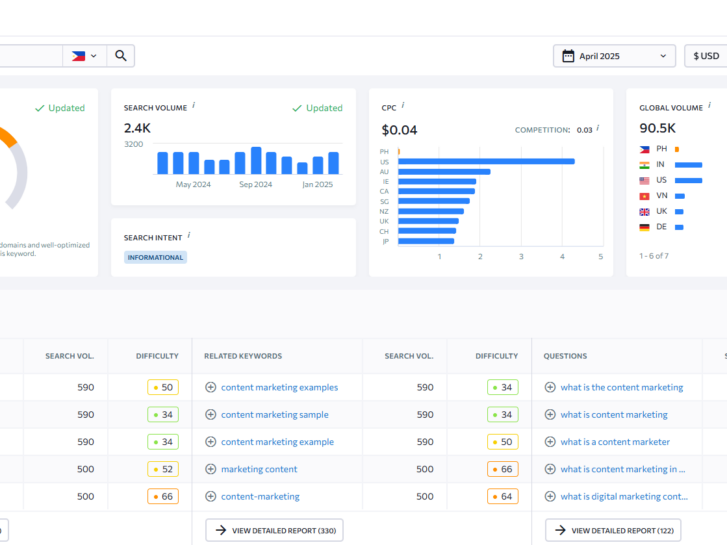Content Pillars 101: A How-To Guide for Beginners
Have you ever written blog posts for your website and found yourself asking, “Why isn’t any of this getting results?” Well, the secret to getting what you want from your content is in mastering how to make content pillars—a proven strategy that helps you rank higher on Google and drive consistent organic traffic. While content pillars aren’t new, they remain one of the most effective ways to structure your content for maximum impact.
In this guide, I’ll break down what content pillars are, why they matter, and how you can use them to dominate search results. Plus, I share real-world examples, a step-by-step workflow, and common mistakes to avoid to help you create a high-performing content pillar strategy that works.

What Are Content Pillars?
At its core, a content pillar is a comprehensive piece of content that serves as the central hub for a specific topic. It acts as the foundation around which all related subtopics are built on. While providing a broad overview, it strategically links to multiple related blog posts—known as “content clusters”—that dive deeper into specific aspects of the subject.
Think of it like a bustling city. The main roads, wide and well-traveled, represent the Content Pillar, guiding the flow of information. Meanwhile, the smaller side streets that branch off and loop back to the main road symbolize the cluster content, each offering a more detailed look at different facets of the topic.
Here’s another example, think of the content pillar “SEO for Beginners”, the potential cluster posts could be the following:
- What is SEO?
- How to Optimize a Page
- What are Backlinks?
- Technical SEO Basics
Now that we know what Content Pillars are, let’s look at why content pillars are a game changer for your content strategy.
The Benefits of Content Pillars
Content pillars aren’t a new trend, it’s a well known strategy that provides many key benefits for your website. Here’s the many SEO advantages it can provide:
1. Organized Website Structure
Search engines read and understand the hierarchy and relationship between the content in your website. Through content pillars, you can create well thought out website structure.
In turn, you’re able to create a hierarchical organization that will help your users easily navigate through your website and search engines index your pages while boosting your rankings.
2. Enhanced Internal Linking
Internal Linking is a crucial aspect for any SEO project that content pillars easily facilitate. How does it do this? Cluster posts can be linked back to your pillar pages which then strengthens the internal linking matrix which boosts the page authority within your website.
3. Increased Dwell Time and Lower Bounce Rate
When visitors can easily find related content, they’ll spend more time on your site. This increases dwell time and reduces bounce rates, both of which are positive signals for Google’s algorithm.
4. Increased Authority on a Topic
Your website can establish itself as an authority on a specific topic. By focusing on a central theme, the subsequent cluster content signals to search engines that you’re an expert on the topic you’ve chosen. In turn, this helps you rank further in the search engine results page.
5. Targeting Long-Tail Keywords
Using content pillars allow you to make use of long-tail keywords, which are less competitive and easier to target. If you link cluster posts to your pillar content, you will be able to rank for a wider range of search queries related to your core topics.
6. Improved Crawlability and Indexing
Search engines work around a hierarchical structure that it views as logical. When you follow proper website structuring, this ensures that all of your pages are indexed properly, in turn will improve your overall SEO performance.
7. Better User Experience
User experience can be improved through the use of content pillars. It creates a well organized and easy-to-navigate website structure that is appealing to users. DoiIn turn, this will lead to higher website engagement and longer time spent on your website which will positively influence your SEO performance.
Step-By-Step Guide: How to Create Content Pillars
Now that you know what content pillars are and how it can benefit you, let’s start on how to make content pillars. Here’s the process broken down into simple, actionable steps:

Step 1: Choose a Core Topic
Pick a broad topic that’s relevant to your brand or niche—just make sure it’s not too broad that you end up targeting a range of topics too wide.
Examples:
- For a travel blog: “Backpacking in the Philippines”
- For an SEO agency: “Technical SEO Guide”
- For an online store: “Sustainable Fashion Essentials”

Step 2: Do Keyword Research Around the Topic
Use tools like SE Ranking, Semrush, or Ahrefs to:
- Identify keywords your audience is searching for
- Group related keywords into clusters
- Prioritize based on search volume and competition
If your pillar is “Content Marketing,” related keywords that come up might include:
- “Content Calendars”
- “Repurposing Content”
- “Content Marketing Tools”

Take note of these, as they might be useful for the next step.
Step 3: Plan the Content Cluster
Now it’s time to map it all out. Use a spreadsheet, mind map, or content planner to:
- List your pillar topic.
- Brainstorm at least 5–10 supporting blog posts – this is where the related keywords come in.
- Assign target keywords per blog post, and plan publication dates.
Doing this will allow you to properly space out when your cluster content is posted, to prevent content spamming.

Step 4: Create the Pillar Content
This is your “Ultimate Guide.” With a minimum of 1,000 words, cover the topic broadly, and have sections that reference or cover the topics that you will later write in-depth in your cluster content. Use headers, visuals, and data to make it engaging to users.
Make sure:
- It’s easy to read and navigate.
- You use your target and related keywords naturally.
- Each section provides a high-level overview of all key subtopics.
- To provide internal links to the cluster content for readers who want more details.
Step 5: Build and Link the Cluster Posts
Each subtopic that you covered in your content pillar is then expanded upon in separate, more detailed cluster content pieces. This is then interlinked from your cluster content and the content pillar.
Make sure:
- To provide in-depth explanations, case studies, statistics, or step-by-step guides (or other supporting information) for your given topic.
- To link back to the pillar page with relevant anchor text.
- To link to other cluster posts where it makes sense.
- Optimize each post for one long-tail keyword.
This cross-linking reinforces your pillar and helps Google crawl your content efficiently.
Example of a Content Pillar in Action
Let’s say you’re a content creator running a food blog in the Philippines. Here’s how you could structure a pillar:
- Pillar Topic: Ultimate Guide to Filipino Cuisine
- Cluster Posts:
- “Traditional Filipino Dishes for Every Occasion”
- “Regional Flavors: Exploring Luzon, Visayas & Mindanao”
- “Filipino Food and Cultural Heritage”
- “Cooking Filipino Food 101: Recipes to Get You Started”
- “Philippine Ulam: The Delicious Main Courses”
- “Best Filipino Desserts and Kakanin”
- “How to Eat Like a True Local: Filipino Street Food and Fast Food”
- Cluster Posts:
Each of those cluster posts links back to the guide and to each other where appropriate.
How to Keep Your Content Pillars Up-to-Date
Making content pillars isn’t a one time project. You have to update the content from time to time or you stand the chance to drop in rankings. Here’s how you can maintain them:
- Update regularly: Add new data, examples, or trends.
- Monitor performance: Use Google Analytics or Search Console.
- Link to new posts: When you publish related content, update your pillar to include a new link.
By doing this, you can keep your content fresh—and search engines love that. I have a guide on when to update your content, and how to “revive” old blog posts if you need more help on this step.
Common Mistakes to Avoid
If you’re just starting out, here are a few things to watch out for:
- Picking topics that are too broad (e.g “Food” instead of “Filipino Food for Newbie Travelers”). Pay attention to keyword volume and difficulty to see if targeting them is feasible and valuable for your website.
- Forgetting internal links–cluster topics should always link back to pillar content (and other related blog posts, if you can).
- Not conducting keyword research. SEO tools are a powerful and efficient way to find related keywords for your cluster topics.
- Letting your content become outdated.
As long as you can avoid doing these things, you can increase your rankings and keep them.
Key Takeaway
Creating content pillars isn’t just another SEO strategy —it’s a surefire way of creating a solid content strategy. By making sure your content is structured around themes, both your audience and search engines will be able to understand your website better.
If you haven’t tried making content pillars before, I recommend starting now. Begin with mapping your core topics, create that cluster content, and make an internal linking system. Trust me, your rankings (and your readers) will be thanking you for it.
